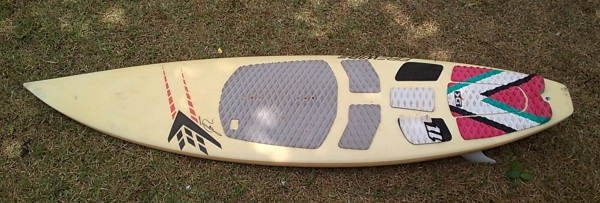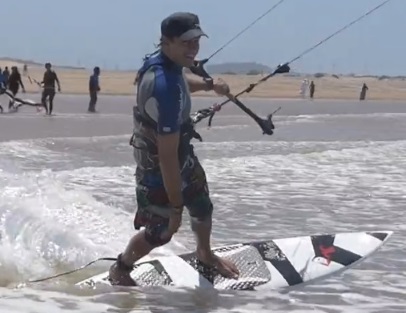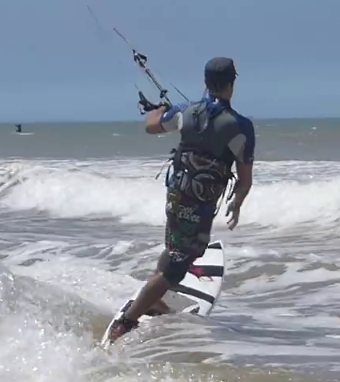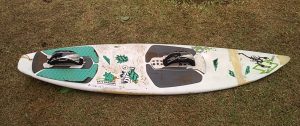 If you’re wondering whether to choose a twintip or a directional kiteboard for kitesurfing, welcome to the club! This is a recurrent question among kiteboarders and one for which everyone has a different answer.
If you’re wondering whether to choose a twintip or a directional kiteboard for kitesurfing, welcome to the club! This is a recurrent question among kiteboarders and one for which everyone has a different answer.
Should you ride a surfboard or a twintip kiteboard? How different is it riding one vs the other?
Kiteboarding on a directional board is very different from riding a twintip. While a twintip is great for flatwater and doing freestyle jumps, a directional board allows for soulful and relaxed carving in waves. Riding a surfboard means learning a new stance, toeside riding, and jibing. Riding strapless is generally easier on your body.
In this post, we’ll first go over the riding styles and conditions that are best suited for twintip vs directional. We’ll also talk about the skills needed for riding a surfboard for kiteboarding, whether to go strapped or strapless as well as the health benefits of using a surfboard vs a twintip.
Table of Contents
Twintips are great for getting started
Most people (including me and probably you) learn to kitesurf on a twintip. Twintips are wakeboard-like boards 125-150 cm long and 35-45cm wide, with straps to tuck your feet in – hardcore freestylers even have snowboard-style bindings for wearing boots.

Besides small size, a twintip kiteboard’s main characteristic is that it’s symmetrical and so can be ridden in both directions without switching feet. When you learn to kiteboard, you first learn is the waterstart, followed by getting up on your board and riding in one direction, then riding back in the opposite direction.
So as you ride out offshore, you have your right or left foot forward depending on wind direction, then when you ride back toward the shore, your other foot is the one in front. All you did when turning was to turn your hips and shoulders in the reverse direction, without ever having to take your feet out of the straps.
This makes it easier for most beginners to learn to change direction as they can just focus on controlling their kite to make it turn. A twintip also helps you learn to ride upwind.
Twintip vs surfboard riding goals
Besides learning, a twintip works great for flat water kiteboarding and doing jumps and tricks. A twintip typically can ride fast, can pop really well, and is short and lightweight enough for easy moving in the air when doing freestyle.
Directional kitesurf boards, on the other hand, are primarily designed to ride waves – after all, they are surfboards. However, kiteboarders who start riding on a directional board quickly discover a very different riding style, even without waves.

Kitesurfing on a surfboard gives you a distinct feel from a twintip. It typically feels more relaxed, with more space for moving your feet. A surfboard generally has a bigger volume than a twintip and so has more buoyancy. You focus more on positioning your feet than on pushing hard on the board.
On similar wave/wind conditions, rider weight, and kite size, a directional board can go upwind much better than a twintip. A surfboard with the right shape can also cut through the chop more effectively – although some twintip boards perform better than others.
Because of drag, a directional board may not go as fast as a twintip kiteboard in flat water. You may also not feel as comfortable in high wind on a surfboard because of the greater board surface. Surfboards, however, are more stable and comfortable to ride on when strapped.
Finally, a directional board offers great carving, that is the ability to perform tight successive turns, including on the face of a wave. Although you can ride waves on a twintip board, you’ll be hindered by the square shape and short length and will not get that unique carving feeling.
Challenges of directional surfboard vs twintip
Based on my experience, the main challenges of directional surfboard riding vs twintip kiteboarding are the following:
- Stance & foot pressure
- Toeside riding
- Switching feet (jibing)
- Edging upwind (flat vs rail)
Stance on directional surfboard vs twintip
When you ride on a twintip, most of your weight is on your back foot (80/20). Your back knee is bent and your front knee extended as you dig your front heel into the board rail to push and make it edge upwind.

When riding a surfboard, you typically position your feet further apart. Most of your weight is onto your front foot (60/40) to keep your board flat on the water. Your general stance is more relaxed, standing upright in a normal way with your knees unlocked.
You only bend your knees further when you need to lower your center of gravity or for edging upwind – pushing downwind with your back foot to add pressure into the fins, and upwind with your front foot.
Jibing on a directional board
As I mentioned earlier, a great advantage of a twintip is that you can ride in both directions without switching your feet, which comes naturally for most learners (except those with a strong previous surfing background).
A directional board, on the other hand, can only ride in one direction (fins in the back), so changing direction is a bit of a challenge. Jibing involves switching feet, i.e. your back foot goes to the front and front foot to the back. After jibing you face toward the opposite direction on your surfboard- right / left.
Simultaneously, you steer your kite over your head into the other half-window, driving you in the reverse direction. The goal of the whole maneuver is for you to start facing your kite again after the turn – if you didn’t switch feet, you’d have the kite in your back while riding toeside.
Learning to jibe is usually the biggest challenge for new riders and twintip kiteboarders transitioning to a directional board.
If you’re strapless, you have to move around the board while having your kite pull you up slightly to help you cross your feet without losing your balance.
If you’re strapped, things are even more challenging as your first need to get your feet out of the straps and tuck them back in after the switch, all while maneuvering your kite.
You can switch feet either before or after turning your kite and board in the reverse direction. It’s a matter of preference and comfort for each rider. Personally, I naturally feel much more comfortable with my left front forward, so when I’m riding in that position I only switch after the turn.
Conversely, if I’m riding with my right foot forward, I typically switch before turning (i.e. sooner). Whichever approach you choose, expect to fall a lot at first when practicing your jibe.
Kiteboarders who are just learning to ride on a directional board initially get off their board and jump in the water when they’re ready to change direction. They turn the board manually and perform a new waterstart in the reverse direction. You’ll typically do this until you master jibing.
Riding toeside on a directional kitesurf board
Most kiteboarders on twintips quickly learn to ride toeside – putting your weight on your toes vs your heels, edging upwind by digging the toeside rail of your kiteboard instead of the heelside rail. When you ride toeside, your turn you back to your kite instead of facing it.

Riding toeside doesn’t feel natural at first and is even considered a freestyle trick on a twintip – it’s an important prerequisite for complex freestyle maneuvers and jumps. Riding a directional board, however, particularly in waves, mastering the toeside stance is mandatory.
Some surfboard riders actually don’t need to ride toeside much because they’re just as comfortable riding with either foot forward – that is, in both regular and goofy stance. Most riders, however, have a single natural position (as is my case, I’m a strong regular-footer).
To carve tight turns on a wave, I need to be in my natural stance, which in my case means facing toward the right side of my board (left foot forward). However, if the wind also comes from my right side, this means I’ll have the kite in my back, and will be riding toeside. Makes sense ?
Toeside riding is relatively pain-free on a twintip once you get the hang of it, you just need to lean forward hard to dig the toeside rail and maintain tension in the lines (which go out behind your back).
On a bigger surfboard, in contrast, riding toeside requires significant effort in your thigh and calf muscles, which you need to build up initially. Focusing on shifting more weight onto your front leg than on a twintip helps relieve the strain on your back leg muscles.
Edging upwind on a directional board
One last challenge I’ll mention for anyone switching from twintip to kitesurfboard is edging. On a twintip, edging upwind requires you to really dig the rail into the water with the other rail sticking out of the water – other kiters can actually see the bottom of your board.
On a directional surfboard, you’re often able to ride upwind while keeping your board flat on the water. In flat water, all you have to do is push on top of the fins are with your back foot, letting the fins do the edging without having to dig your rail like on a twintip.
In choppy or wavy conditions, however, your board’s fins have less grip in the water due to the slap and bounce, so you need to dig your rail in harder like you would on a twintip. Unlike on a twintip though, you typically put equal pressure on both feet so that your entire rail edges evenly.
When should you start riding a directional kiteboard?
If you’re new to kitesurfing and your only goal is to ride waves, you may be tempted to learn to kitesurf on a directional board from scratch, without going through the twintip stage.
As I mentioned earlier, twintips are easy to learn on due to their smaller size and weight and their symmetrical shape which makes them bi-directional. Some riders, however, argue that a surfboard can be easier to learn on due to the added buoyancy and the large standing surface.
Most schools teach beginners using twintips as these boards allow learners to somewhat forget about the board and concentrate on the kite. A surfboard, even with straps, is not so easy to handle if you can’t yet control your kite well.
As mentioned earlier, turning around on a surfboard through either jibing or toeside riding constitutes another big challenge for a beginner kiteboarder.
Of course, if you’re already a surfer, you may feel more comfortable getting starting on a surfboard, as riding in both directions (regular and goof stance) on a twintip may feel quite unnatural to you.
The challenge of learning to jibe, however, will still be there and won’t make your learning any easier. A lot of learners with previous board sports experience choose to go back to using a twintip until their flying, waterstart, and turning skills are good enough.
Strapped vs strapless directional board vs twintip
Does using straps make a difference when it comes to comparing riding a directional board vs a twintip? Sort of. A strapped surfboard may feel more natural to a twintip kitesurfer because she can dig the rail in for edging in the same way and even do small jumps.
It’s easier when strapped to adjust your body weight and pressure distribution between front and back leg. The straps make riding the surfboard more forgiving by helping you balance out and correct.
For newer directional board riders, straps also make it much easier to edge upwind. You also get a more secure and locked-in feeling which allows you to take more risk for powering your kite or jumping waves.
The biggest con of using straps, however, is for turning! Every time you do a jibe to change direction, you first need to prepare for it by getting both feet out of the straps and putting them back in after the turn. This takes time and practice and makes turning more challenging.
You must also practice slipping your back foot into the strap when you’re about to drop down a wave or set up for a jump. When you’re not using it, however, the rear strap often gets in the way of smooth moving.
Many kiteboarders who ride a surfboard use only the front strap and keep their back foot free – sometimes even taking the back strap off altogether. This still gives them the secure lock-in feel for the front foot while removing half the hassle when switching stance.
Riding strapless sets your free and lets you ride your surfboard in waves like you would without a kite. You can still dig the rail in hard for going upwind but it requires more skills and practice as you have to maintain constant pressure with your feet onto the board, and power your kite just enough to allow that.
Turning is easier strapless than strapped since you don’t have the footstraps getting in your way.
Strapless kitesurfing is completely different from riding a twintip. Although the kite flying skills are the same, the conditions you will typically ride in, the maneuvers you’ll perform, and the feeling you’ll get make them very distinct styles.
Many kiteboarders who try strapless kitesurfing never look back. Some, however, continue to alternate between the two: twintip for big jumps and freestyle tricks and surfboard for riding waves and freeriding.
Health benefits of using a directional board vs a twintip
The last point I’d like to mention is that switching to a surfboard for kitesurfing, first strapped then later strapless, has completely wiped out my knee and hip pain.
Riding a twintip puts tremendous strain on your knees, particularly in choppy conditions – which I get most of the time.
Also, the hard edging required to stay upwind on a twintip involves rotating the hips and upper body to make them face forward, which for me involves a nasty rotation of the hips and lower spine. I used to feel exhaustion and joint pain after each twintip session for a couple of days.
Switching to a directional board changed my kitesurfing life. I could stand upright and not flex my legs so hard. I no longer had to hold that dramatic upper body rotation when riding. Going strapless relieved even more pressure on my knees and hips.
For me, there’s no going back. If you’re comfortable riding upwind on a twintip, you should definitely give a directional kiteboard a try. At the very least, you’ll discover a brand new discipline and start riding waves in addition to freeriding/freestyling.




Thanks, great articles and helpful info.
What do you look for in a strapless surfboard as far as length, shape, rocker, etc? I got into kiting because I surf and am now committing to figuring out wave riding on a kite & strapless. Thanks again
Hey, check out this post it has all the info based on my personal experience.
Ride on!
Thanks